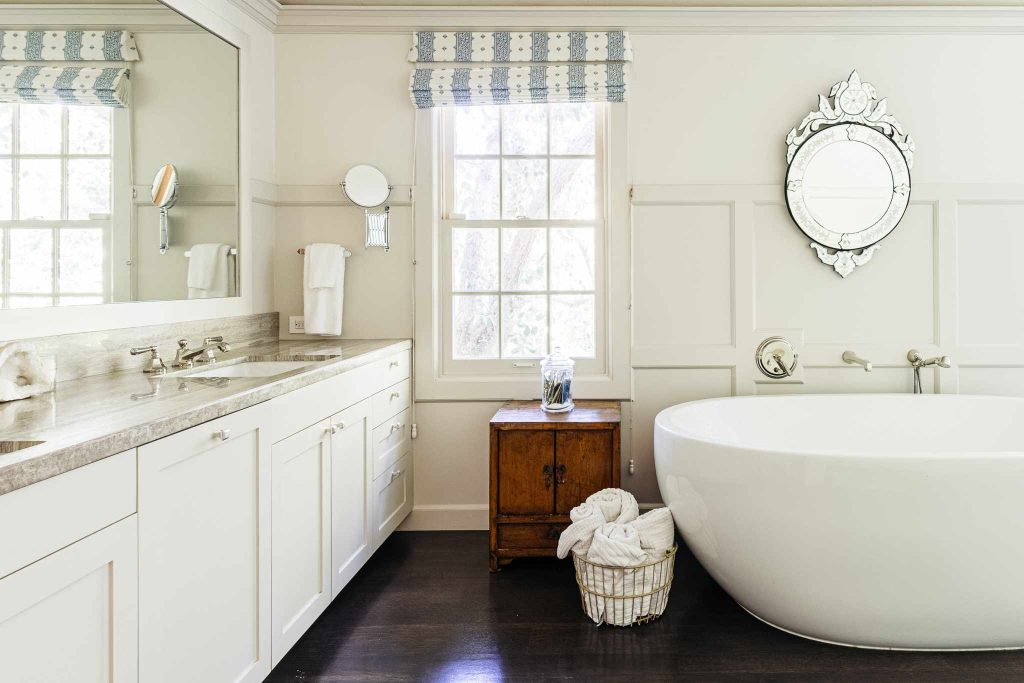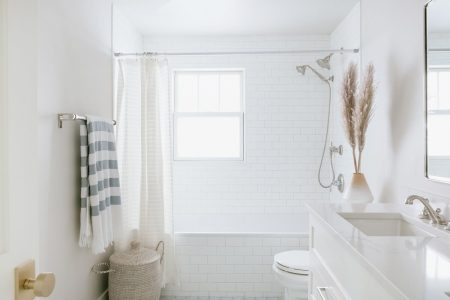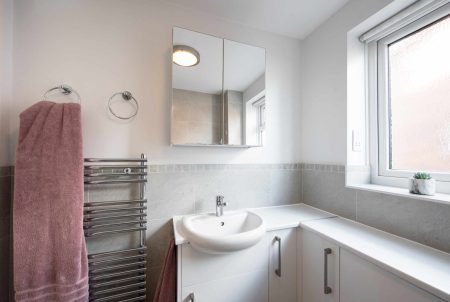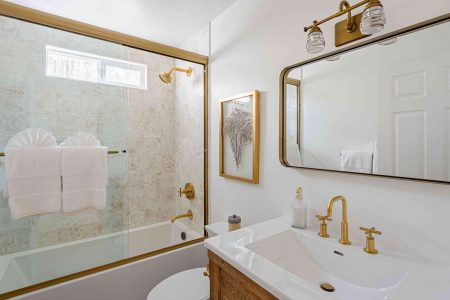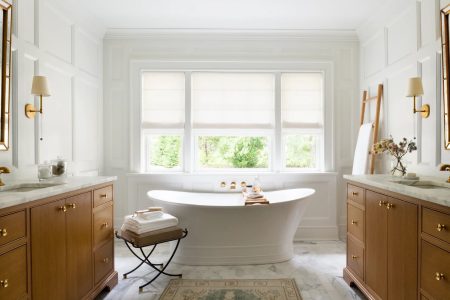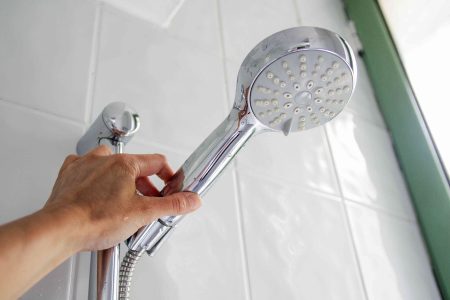Hardwood flooring is a popular surface covering material that has been used in a variety of interior spaces since the dawn of modern construction. It is durable, low maintenance, long-lasting, and has a beautiful natural look that is prized by many homeowners. However, it does have issues when used in moist or humid environments, such as bathrooms. While certain types of hardwood flooring can be successful in bathroom use, wood in the bathroom will require a higher level of maintenance than in other places.
Advantages of Hardwood in a Bathroom
Despite some drawbacks, there are distinct aesthetic advantages to using hardwood flooring in a bathroom.
Warmth
One of the biggest drawbacks to ceramic tile is that it is quite chilly, especially in the winter. Since the bathroom is a space where you will often go barefoot, this can be an issue. Hardwood floors give the room a much warmer, more comforting feel underfoot. The earth tone colors also tend to make the entire room seem more inviting and welcoming.
Beauty
The biggest advantage of hardwood is that it can be really beautiful. It lends a sense of natural wonder to spaces while also providing a unique appeal—every plank is a piece of natural artwork with its individual grain pattern. Hardwood is a classic choice that has transcended centuries of style and it isn’t subject to the whims and vogues of interior design. A bathroom floored with hardwood will draw attention as an elegant space. It can also offer design continuity between rooms.
Longevity
Properly maintained, a solid hardwood floor is a very durable, long-lived flooring material. Lifespans of 25 years or more are common, making hardwood flooring one of the most durable flooring options available along with stone or ceramic tile. When hardwood does become scratched, it can be sanded and refinished to renew the surface. Engineered hardwood flooring, made of a hardwood surface layer laminated to core layers, is somewhat less durable, but it can still be a long-lasting floor when properly maintained.
Dangers to Hardwood Flooring In a Bathroom
The issues affecting hardwood flooring in a bathroom all involve the way that moisture can affect the material.
Spills and Splashes
This is going to be the first concern of any flooring installed in a bathroom. Showers and baths naturally tend to cause splashes. Even just rinsing your face in the sink can send droplets of water spilling out across the floor, and a bathroom with a shower or tub is almost certain to see water on the floor occasionally—especially a bathroom used by children. While the finish will protect the material to some extent, you still need to wipe up any spills immediately so that the moisture doesn’t wear away at the material’s protective layer or seep down between seams. Many manufacturers stipulate this—the warranties are voided if the recommended methods of cleaning up are not followed.
Floor Slope
If your floor is not perfectly level, you’re going to have a problem with water sliding down towards the low areas and puddling. These puddles of moisture can be very damaging to the floor, and can even weaken its structural integrity—mostly because the water seeps through seams. Proper preparation of the subfloor to create a perfectly level and flat base is essential to preventing water damage on a hardwood floor.
Lack of Moisture Barrier
Many hardwood floors are installed by nailing planks directly to the subfloor, which means that a traditional vapor barrier can’t be used since the nails would puncture it. If moisture seeps down past the surface, it can get to the structural components of the floor and start eating away at the subfloor and underlayment. For this reason, hardwood flooring products that are installed with adhesives or click-together methods are better suited for a bathroom setting.
Flooding
Flooding is a constant threat in a bathroom, but the dangers are exacerbated when you have hardwood flooring. If a pipe starts to leak or a fixture malfunctions, you can very quickly find the bathroom filled with inches of water. Though you may be able to undo some of the damage, flooding will generally destroy a hardwood flooring installation, even if it is properly sealed. Almost no hardwood floor can seal against a complete flood. In a home with old plumbing, you should think carefully before risking a hardwood floor in kitchens or bathrooms.
Chemical Staining
There are many different types of soaps, cleansers, and body products that are used in bathrooms. Many of these are slightly acidic in nature, and if they spill and splatter on hardwood, they can eat away at the finish or cause permanent staining in the wood. Cleansers will need to be cleaned up quickly and thoroughly if they get on hardwood flooring.
High Humidity
While standing water caused by splashing gets the most attention in a bathroom, the humidity in this space can be just as damaging. When you shower, the bathroom tends to get very steamy, with the air growing warm and moist. This air will hover in the space, filling every crack, penetrating down into every tiny space, infiltrating the hardwood floors. While only a small amount will actually get in, over time, the effects can accumulate.
Unfortunately, humidity can attack every side of the hardwood—even the bottom, which generally does not get a finish treatment. In the case of a heavily used bathroom, humidity can result in floorboards twisting, warping, plumping and cracking.
Bathrooms with hardwood flooring should have good exhaust fans, which should be run for a good length of time during and after a shower or bath.
Mold and Mildew
Because the bathroom is so moist, the growth of mold and mildew is always going to be a problem. These harmful organic substances love hot, wet environments, and they feed on natural organic materials such as hardwood. The finishing coating will protect the floor to some extent, but over time, mold and mildew can grow in between boards, and even beneath them. Mold and mildew are problems whenever they occur, but they can be quite serious for people who have allergies and sensitivities.
Strategies for Preventing Damage to Hardwood
Tactics are aimed mostly at preventing moisture from contacting the wood, and especially from seeping down through the seams to the subfloor.
Regular Maintenance
Keeping the floor’s finish layer strong and intact is vital when you have hardwood flooring in a bathroom. This is your first line of defense, and it will need to be reapplied every few months. You can test if the finish layer is still intact by dropping a small amount of water on it and waiting to see if the water beads up or is absorbed into the wood. If it beads up, the finish is fine, but if it sinks in, then you need another topcoat of finish as soon as possible. Pay particular attention to cracks between floorboards.
Use Bath Mats
These can be placed at strategic locations, such as just outside of the bathtub or around the sink. Catching any splashing water droplets or drips from wet freshly washed feet can prevent floor damage. If a bath mat becomes saturated, make sure to air-dry it so it can’t hold moisture against the floor. The best bath mats will have a solid rubber or vinyl backing that prevents moisture from passing through.
Install Tub and Shower Surrounds
Another way you can prevent water damage is to install surrounds along the perimeter of the bathtub. These can provide a stylish match with other features of the room, but the real merit is their ability to keep water in its place—which is not on your beautiful hardwood floor.
Also, keep the joints around shower stalls properly sealed, since this is a place where water can easily escape out onto hardwood flooring.
Maintain Plumbing Fixtures
The pipes running into and out of the major fixtures in a bathroom can also be a problem. These can sometimes leak, causing water damage problems in hard-to-see areas. Cold-water lines or the toilet tank may also collect condensation, due to being cooler than the surrounding air in the bathroom, and this can also lead to water issues as condensation drips down to the floor. The best way to handle this is to ensure that all pipe openings are thoroughly caulked and to keep an eye out for any leaks or drips. The valve connections beneath a toilet or pedestal sink are prime places where water can drip onto a floor.
Refinishing Hardwood Floors in a Bathroom?
One of the great things about hardwood is that if you mess up and ruin the floor, it can generally be fixed by simply sanding down the surface past the level of any defects and then applying a new finishing coat to it. Be aware, though, that the equipment normally used in other rooms to refinish hardwood is quite large and unwieldy. In many bathrooms, this will be done best with hand power sanders rather than large machines, and so the process may be harder and more time consuming than you first imagined.
Shopping Considerations
When deciding if hardwood flooring is right for your bathroom, consider these factors:
Finish
In its unprotected state, hardwood flooring will plump, expand, warp, and stain at the touch of any liquids, because wood is naturally a very absorbent material. However, the application of a finishing agent, usually a polyurethane-based sealer, can create an invisible surface over the wood, making it impossible (or at least difficult) for water to penetrate. This finish will generally have to be reapplied at regular intervals in a bathroom, with special attention to the seams, since this is where moisture is most likely to infiltrate.
It is very important that you choose a quality finish that is designed for water-heavy environments. There are some finishes that are marine-grade, suited even for outdoor all-weather applications. Others will be acceptable for indoor use in damp spaces, though not fully waterproof. You also have to be aware that the sealer will only protect the top of the material; any water that penetrates down through the seams can cause damage to the wood from the sides and below.
Type of Wood
There are many different types of wood that are available for flooring installations, and some will be better than others at handling bathroom conditions. Generally, you should avoid softwoods such as pine and fir, as they will be less dense and more apt to absorb moisture. Good hardwood choices include teak, oak (especially white oak), cedar, cherry, maple, ash, walnut, and hickory.
Warranty
Most hardwood flooring will come with a set warranty that will guarantee replacement over a certain period of time if the material fails. However, these warranties often come with stipulations that void them if the floor is installed in a water-heavy environment, such as a bathroom. Or they may define the flooring as “moisture-resistant,” which usually means that you are expected to wipe the flooring dry immediately after condensation or spills contact the surfaces. Your warranty is voided if you fail to do this, and wood floors are never warranted against flooding. Always read the product literature carefully if you plan to install wood flooring in a bathroom or other damp area.
Consider the Usage
Hardwood may not be the best flooring choice in a heavily used bathroom where children will splash around, but it can be perfect in a guest bath or powder room that contains only a vanity, and where there’s little chance of water puddling on the floor. Unless you’re up to the task of diligent maintenance, you may want to reserve hardwood flooring for bathrooms where it is most appropriate.
Read the full article here







